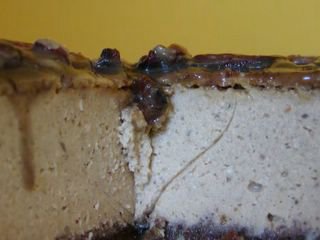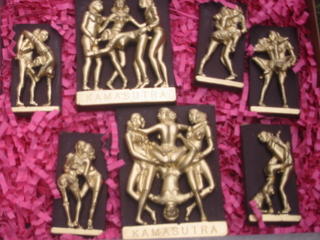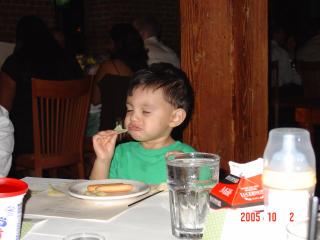My friend, Leon Lee, sent this along. At first glimpse I find myself gawking at the idea of such rigid "scientific method" study of food. On the other hand, isn't it always fun to hear about the huge gap between our folk knowledge and what research tells us? Who knew that Iron Chef had science behind its eccentric combos . . .
Food: his passion, his scienceHervé This, a French researcher, helps chefs around the world really sizzleBy Émilie Boyer King Contributor to The Christian Science Monitor
PARIS - Cooking a cheese soufflé can be tricky. Despite following the recipe meticulously, using the finest ingredients, and heating the oven to the perfect temperature, you can still end up with a cheese cookie instead of a fluffy, brown-topped soufflé intended to impress your guests. The result, it seems, is often arbitrary.
But help is at hand. Tucked away in their laboratories, a bunch of dedicated scientific foodies are toiling away to solve the soufflé problem and other culinary conundrums: Should jam be cooked in a copper pan? When gnocchi come floating to the surface of boiling water, does that mean they are cooked? Molecular gastronomy - a branch of food science that focuses on cooking and food preparation (rather than on the chemical makeup of food, as traditional food science tends to do) - has the answers.
The term molecular gastronomy was coined in the 1980s by a French scientist, Hervé This, and Nicholas Kurti, who was a professor of physics at Oxford University in England. Both men were interested in food science, but they felt that empirical knowledge and tradition were as important in cooking as rational understanding.
"We realized there was a growing gap between food science and home cooking," remembers Dr. This, who, since 1995, has worked at the prestigious Collège de France in central Paris, perhaps one of the only science labs in the world to smell of freshly baked cake. "Classic food science ... succeeded in giving the Western populations enough to eat. But it slowly became more interested in food than in cooking."
So This, whose training was in physical chemistry, an area of research that spills into both chemistry and physics, began casting a scientific eye on cookbooks. He started by collecting food-related sayings and old wives' tales to find out if there were a rational explanation behind them.
"Some people think a law is a law. But if a law doesn't work, then you change it. Some traditions don't work, and so you have to change them," This says.
For instance, should roast beef be covered with mustard an hour before putting it in the oven, as an 18th-century cookbook suggests? Should the head of a suckling pig be cut as soon as it is taken out of the oven - so that the skin won't lose its crunch? To this day, This has recorded more than 10,000 adages, each of which he jots down in a notebook. He tries to test as many sayings as possible, and after many lab experiments and a number of failed dinner parties, he has managed to disprove (as with the examples above) or improve upon many maxims.
For This and his colleagues, working in close collaboration with cooks is essential, and This regularly teams up with chefs to exchange information. Every month, he picks a theme based on his research and challenges his friend, three-star French chef Pierre Gagnaire, to invent a recipe from it.
"We work very hard, and Hervé's research helps us to find new perspectives," says Gagnaire, who is known for his innovative cuisine and food combinations.
As a result of this crossover between science and cooking, outstanding restaurants around the world are serving unusual dishes such as tobacco-flavored ice cream made with liquid nitrogen and sardines on sorbet toast. Utensils such as blowtorches, pH meters, and refractometers, which were previously relegated to science laboratories, are now creeping into the kitchen.
Heston Blumenthal, chef at the Fat Duck restaurant at Bray-on-Thames in England, has long been interested in the use of science for cooking, and works closely with molecular gastronomists.
"In late 1999, one of the most widely reported of our discoveries was the combination of caviar and white chocolate," says Chef Blumenthal. "I demonstrated this combination to one of the world's leading flavorists, who was amazed at the marriage.... He went off and came back with a printout [of the chemical makeup] of cocoa and caviar, and surely enough, they both contained high levels of amines.
"This's research helps the Fat Duck staff blend some unusual ingredients. Spice bread ice cream and crab syrup, smoked bacon and egg ice cream served with French toast and tomato jam, and oysters and passion-fruit jelly are a few examples. They may sound odd, but these are winning combinations. Last month the Fat Duck was awarded three Michelin stars, one of only two restaurants in Britain to hold this distinction.
Scientists and chefs alike believe that with the help of science, cooking can be improved. "One of the best ways of standardizing techniques is to use science as a starting point," says chef and cooking teacher Neil Armstrong. "A comprehension of these more scientific principles prior to a practical breadmaking demonstration, for example, enhances understanding and allows the student to understand how successful bread can be made."
In his book "Une Théorie du Goût" ("A Theory of Taste," 1999), This described a set of basic cooking rules, based on his scientific research, to help the chef and everyday cook. The rule of juxtaposition, for example, explains that one ingredient will seem tasteless if it is served with another, more tasty ingredient. Conversely, the flavorful ingredient's taste will be sharpened.
Another rule, the law of dominance, states that an ingredient with a dominant taste (a very sweet-tasting ingredient such as chocolate, for instance) must always be "awakened" by an ingredient with another dominant taste (an acidic food, for example). This principle is confirmed by the popular combination of orange and chocolate.
Molecular gastronomy is gaining momentum throughout Europe. The INRA, France's national agronomic research institute, has made this science a discipline in its own right. The European Union recently backed a three-year research project, Inicon, which is developing innovative technologies to help modernize cooking. And in Italy, the ecological group the Slow Food movement will open a university this year, the first one devoted to academic courses on food. The new University of Gastronomic Sciences will offer topics ranging from the principles of sensory evaluation to nutrition.
Recently, This was awarded an honorary medal by the French government for his services to French culture. But for This, his work has only just begun. Referring to his old friend Pierre Gagnaire, he explains his motivation: "Pierre laughs when I tell him this, he thinks I am far too ambitious. But my real aim is for cooking, by the time I die, to have become far better than it is now."
For the less ambitious, a little scientific help in the kitchen can go a long way, starting with how to make the perfect soufflé. The key, This says, is to heat it from the bottom up to let evaporating water from the cheese and eggs push the soufflé mixture upward. The egg whites must be whipped as firmly as possible so that air bubbles move more slowly through the mixture, pushing it up higher.
Success is guaranteed because the recipe has been tested - scientifically.







